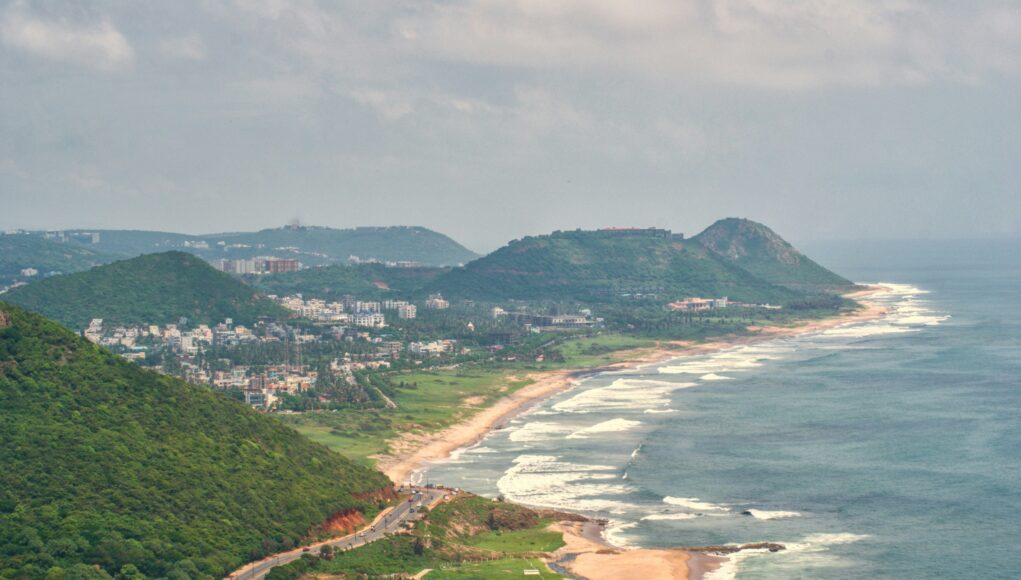Brazil’s coastline stretches for over 7,400 kilometers along the Atlantic Ocean, offering some of the world’s most spectacular beaches.
From the vibrant shores of Rio de Janeiro to the pristine paradise of Fernando de Noronha, Brazilian beaches combine stunning natural beauty with rich culture, warm hospitality, and year-round tropical weather.
Whether you’re seeking dramatic cliff-backed coves, endless stretches of golden sand, crystal-clear waters perfect for diving, or lively beach scenes with caipirinhas and samba rhythms, Brazil’s coastal treasures offer something magical for every beach lover. These six beaches represent the very best of Brazil’s coastal beauty, each offering unique characteristics that make them truly unforgettable destinations.
1. Praia do Sancho, Fernando de Noronha
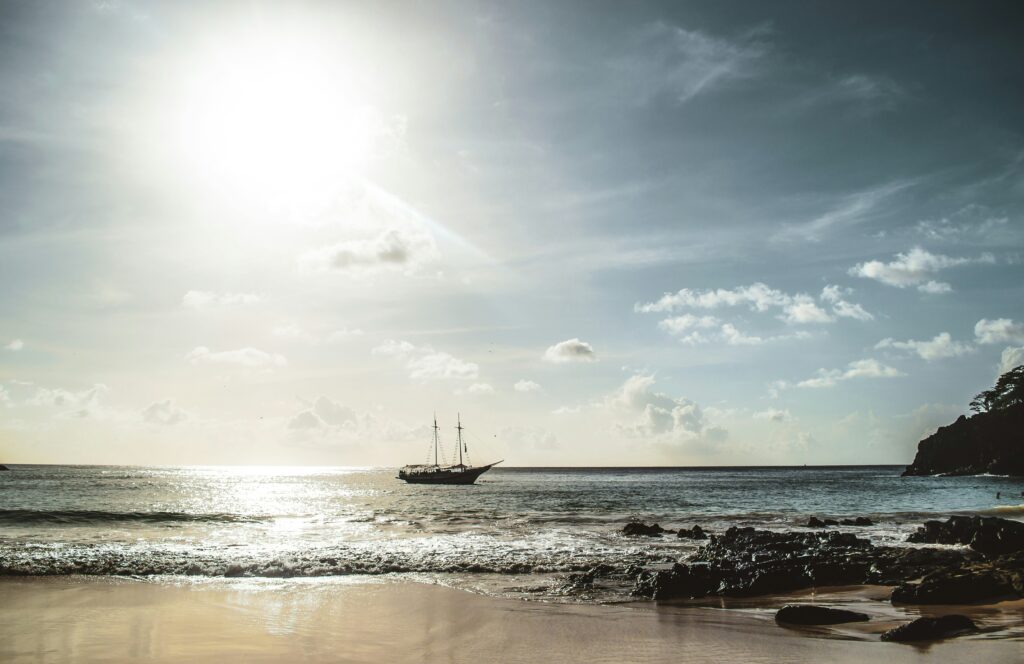
Location: Fernando de Noronha Archipelago, Pernambuco
Best Time to Visit: May to November (dry season)
Access: Boat or hiking trail down dramatic cliffs
Consistently ranked as one of the world’s best beaches, Praia do Sancho is the crown jewel of Fernando de Noronha, a UNESCO World Heritage marine park located 350 kilometers off Brazil’s northeast coast. This pristine beach is accessible only by boat or through a challenging climb down a rocky cliff face using metal ladders and stairs carved into the rock.
The effort to reach Praia do Sancho is rewarded with one of the most breathtaking beach experiences on Earth. The beach features powdery golden sand framed by towering red cliffs covered in lush vegetation. The crystal-clear turquoise waters offer visibility of up to 50 meters, making it a paradise for snorkelers and divers who can observe sea turtles, tropical fish, rays, and even dolphins in their natural habitat.
What Makes It Special:
- Consistently voted world’s best beach by TripAdvisor travelers
- Part of a protected marine national park with strict visitor limits
- Incredible underwater visibility and diverse marine life
- Dramatic cliff formations and untouched natural beauty
- Swimming with dolphins and sea turtles
Travel Tip: Visitor numbers to Fernando de Noronha are strictly limited to preserve the ecosystem. Book accommodations and flights well in advance, and prepare for environmental fees. The island requires a minimum 3-4 day stay to make the journey worthwhile.
2. Copacabana Beach, Rio de Janeiro
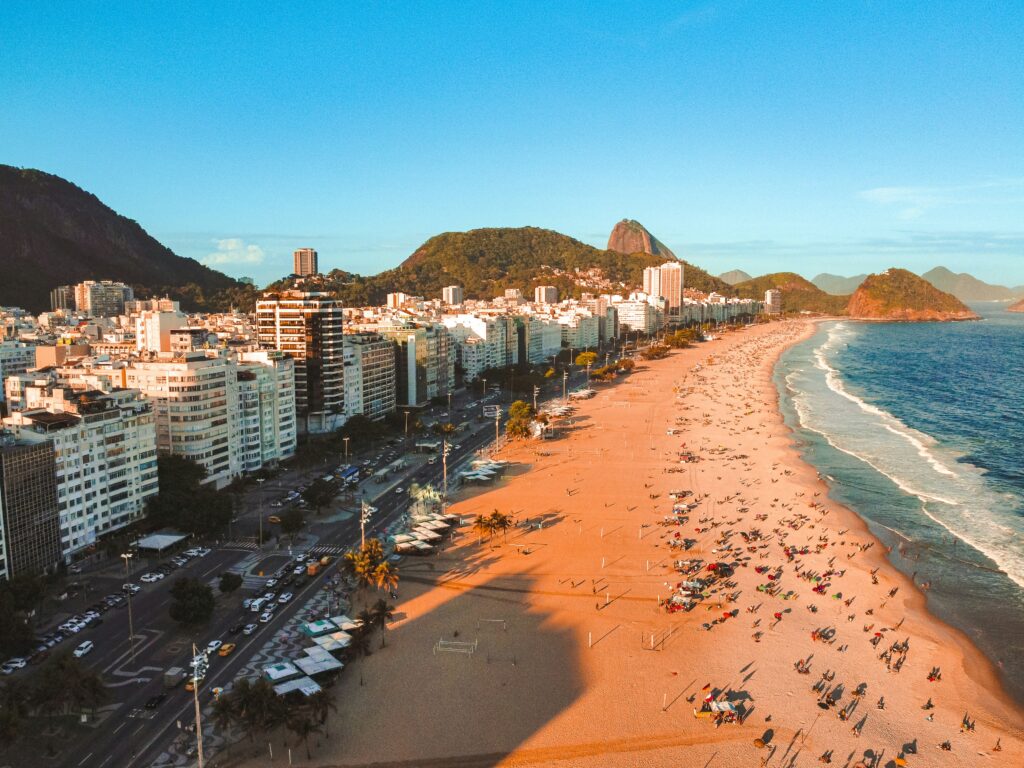
Location: Rio de Janeiro, Rio de Janeiro State
Best Time to Visit: December to March (summer season)
Access: Metro, bus, or taxi to Copacabana neighborhood
Perhaps the most famous beach in the world, Copacabana is much more than just a stretch of sand – it’s a cultural phenomenon and the beating heart of Rio de Janeiro’s beach culture. This 4-kilometer crescent of golden sand is backed by the iconic mosaic promenade designed by Roberto Burle Marx and framed by the dramatic peaks of Sugarloaf Mountain and Corcovado.
Copacabana buzzes with energy from sunrise to sunset. Early mornings see joggers and fitness enthusiasts taking advantage of the cooler temperatures, while afternoons bring families, tourists, and locals who gather to play beach volleyball, soccer, and frescobol (beach paddle ball). The beach comes alive at sunset with street performers, capoeira demonstrations, and the famous beach vendors selling everything from açaí bowls to caipirinhas.
What Makes It Special:
- Iconic curved shoreline with world-famous promenade
- Vibrant beach culture with sports, music, and entertainment
- Historic New Year’s Eve celebrations with millions of visitors
- Stunning backdrop of Rio’s famous mountains and Christ the Redeemer
- Perfect people-watching and authentic Brazilian beach experience
Travel Tip: While beautiful, Copacabana can be crowded and requires street smarts. Keep valuables secure, stay aware of your surroundings, and consider visiting during weekday mornings for a more relaxed experience. The beach is divided into numbered posts (postos) that serve as meeting points and reference locations.
3. Jericoacoara Beach, Ceará
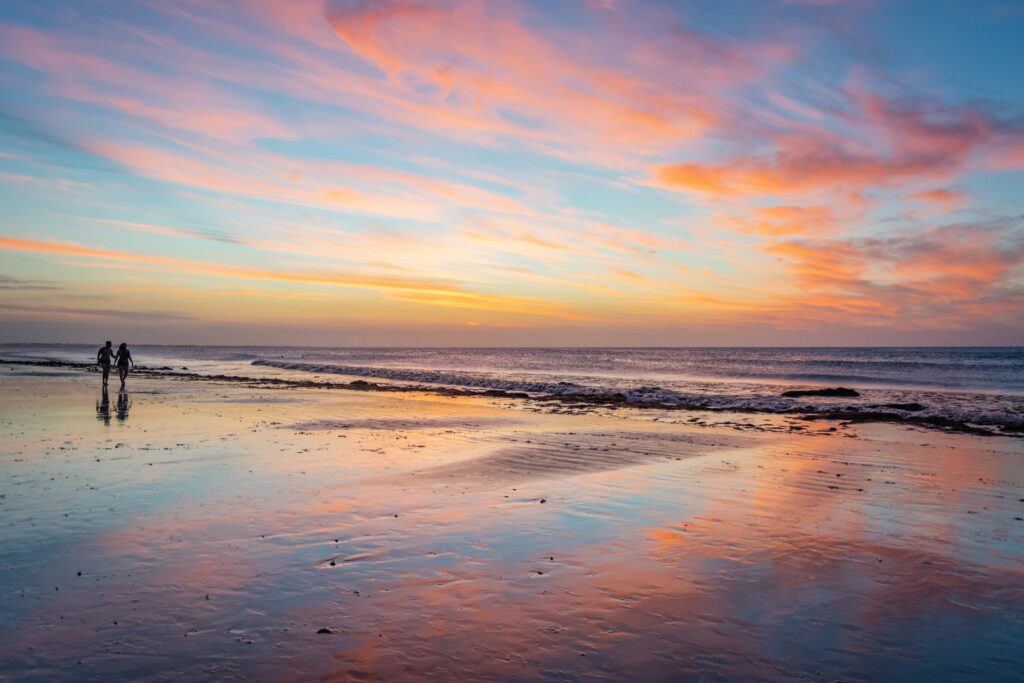
Location: Jijoca de Jericoacoara, Ceará State
Best Time to Visit: July to December (windy season for kitesurfing)
Access: 4WD vehicle from Jijoca (cars prohibited in village)
Hidden within Jericoacoara National Park, this remote beach paradise was once a secret known only to backpackers and wind sport enthusiasts. Today, “Jeri” has evolved into one of Brazil’s most enchanting beach destinations while maintaining its bohemian charm and laid-back atmosphere. The village has no paved roads, no street lights, and no cars – transportation is by foot, bicycle, or horse-drawn cart.
Jericoacoara’s beach stretches endlessly in both directions, featuring fine white sand dunes that shift and change with the constant Atlantic winds. The area is renowned for its world-class kitesurfing and windsurfing conditions, with consistent trade winds from July to January. The famous Duna do Pôr do Sol (Sunset Dune) offers one of Brazil’s most spectacular sunset viewing experiences, where visitors gather each evening to watch the sun disappear into the ocean.
What Makes It Special:
- Car-free village with authentic, rustic charm
- World-renowned kitesurfing and windsurfing destination
- Stunning sunset views from the famous Sunset Dune
- Pristine natural environment within a national park
- Unique lagoons and rock formations perfect for exploration
Travel Tip: Bring cash as ATMs are limited, and book accommodations in advance during peak season (July-February). The journey requires a bumpy 4WD ride through sand dunes, so pack light and protect electronics from sand. Don’t miss the nearby Lagoa Azul and Lagoa do Paraíso for incredible swimming experiences.
4. Ipanema Beach, Rio de Janeiro
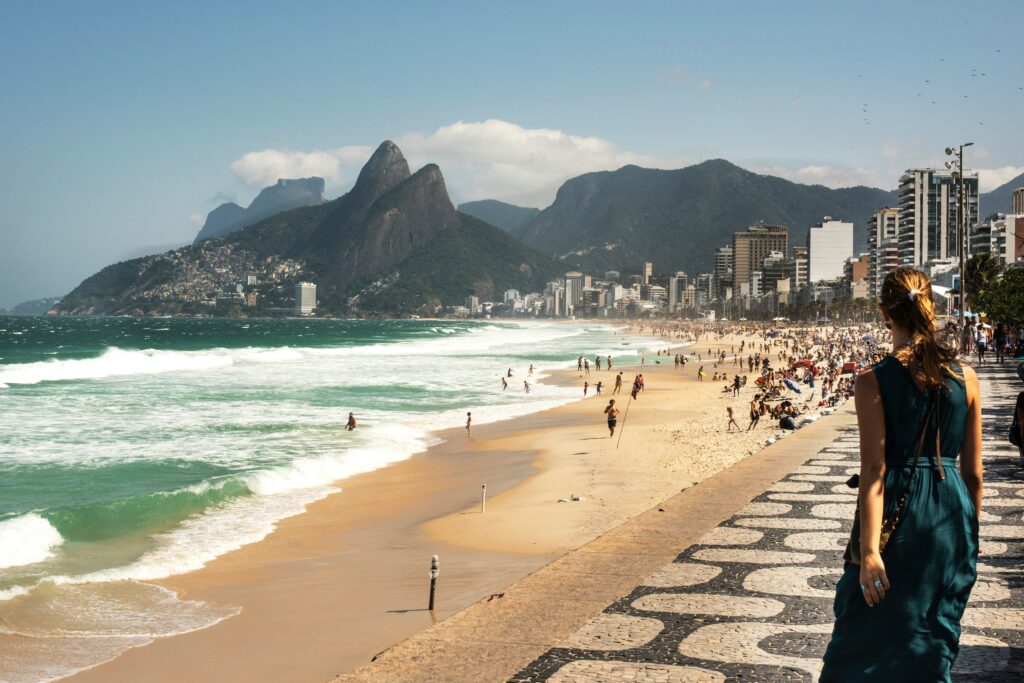
Location: Ipanema neighborhood, Rio de Janeiro
Best Time to Visit: April to June, September to November (shoulder seasons)
Access: Metro to Ipanema/General Osório station
Made famous by the bossa nova song “The Girl from Ipanema,” this sophisticated beach embodies the refined side of Rio’s beach culture. Ipanema attracts a more upscale crowd than its neighbor Copacabana, with trendy beachfront bars, high-end boutiques, and some of the city’s best restaurants just steps from the sand. The beach offers stunning views of the Dois Irmãos (Two Brothers) mountains and is known for having some of the most beautiful sunsets in Rio.
Ipanema’s social scene is as captivating as its natural beauty. Different sections of the beach attract different crowds: Posto 9 is popular with the young and trendy, Posto 8 with families, and the area near Rua Farme de Amoedo with the LGBTQ+ community. The beach culture here is sophisticated yet relaxed, with beachgoers sipping fresh coconut water and açaí while enjoying the constant parade of beautiful people and incredible scenery.
What Makes It Special:
- Sophisticated beach culture with upscale atmosphere
- Stunning sunset views over the Dois Irmãos mountains
- Excellent people-watching and fashion scene
- High-quality beachfront dining and shopping
- Historical significance in Brazilian music and culture
Travel Tip: Ipanema can be expensive, especially for food and drinks. Consider bringing snacks and water, or head to the nearby streets for more affordable options. The beach gets very crowded on weekends, so visit during weekdays for a more relaxed experience.
5. Praia dos Carneiros, Pernambuco
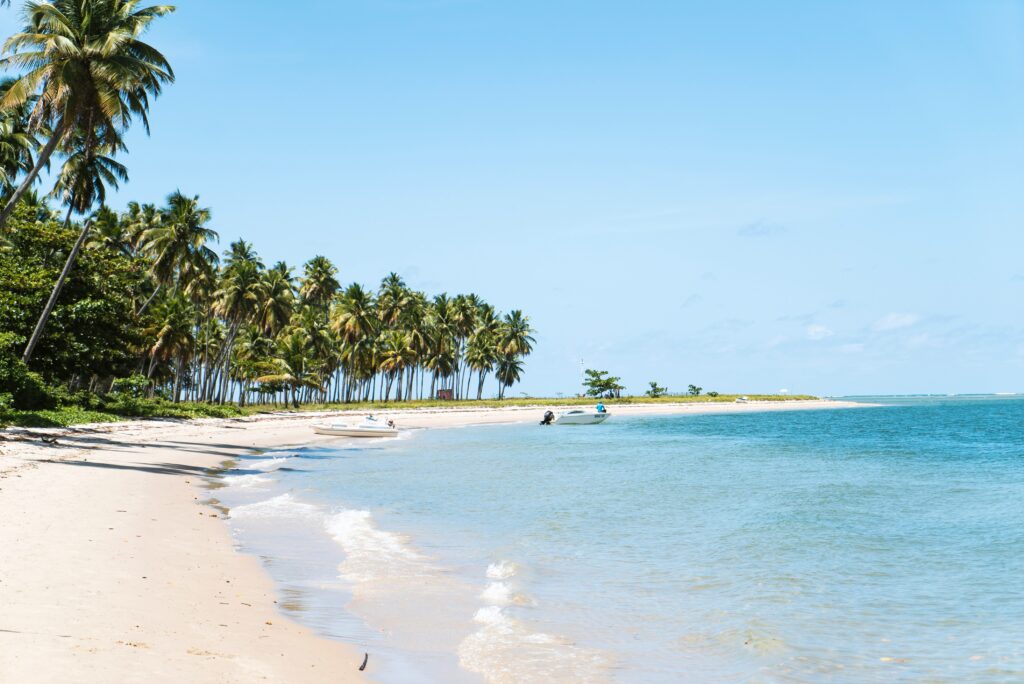
Location: Tamandaré, Pernambuco State
Best Time to Visit: September to March (dry season)
Access: 1.5-hour drive south of Recife
Often called Brazil’s most romantic beach, Praia dos Carneiros is a pristine tropical paradise that seems too perfect to be real. This secluded beach features an incredible combination of white sand, crystal-clear emerald waters, swaying coconut palms, and colorful reefs just offshore. The beach remains relatively undeveloped, with only a few upscale resorts and beach clubs preserving its natural beauty.
The highlight of Praia dos Carneiros is the iconic Capela de São Benedito, a tiny white chapel built in 1686 that sits directly on the beach, creating one of Brazil’s most photographed scenes. The warm, calm waters are perfect for swimming and snorkeling, while the offshore reefs protect the beach from large waves, making it ideal for families. Natural pools form at low tide, creating perfect spots for relaxation and exploration.
What Makes It Special:
- Historic white chapel sitting directly on the pristine beach
- Crystal-clear waters with excellent snorkeling opportunities
- Romantic, secluded atmosphere with minimal development
- Natural tidal pools and protected swimming areas
- Stunning coconut palm groves providing natural shade
Travel Tip: Visit during weekdays to avoid crowds, and consider staying overnight at one of the beachfront pousadas for the ultimate romantic experience. Bring reef-safe sunscreen to protect the marine environment, and don’t miss the boat trips to explore the nearby mangroves and islands.
6. Lopes Mendes Beach, Ilha Grande
Location: Ilha Grande, Rio de Janeiro State
Best Time to Visit: April to June, August to November
Access: Ferry from Angra dos Reis or Mangaratiba, then hiking trail
Accessible only by foot through Atlantic rainforest trails, Lopes Mendes Beach is often considered Brazil’s most beautiful beach by those lucky enough to visit. This 3-kilometer stretch of impossibly fine white sand is completely undeveloped, with no buildings, vendors, or facilities – just pristine nature at its finest. The beach faces the open Atlantic, creating perfect waves for surfing and bodysurfing.
The journey to Lopes Mendes is part of the adventure, requiring a ferry ride to car-free Ilha Grande followed by either a 2.5-hour hike through lush rainforest or a combination of boat and shorter hike. The effort is rewarded with one of the most pristine beach experiences in Brazil, where the powdery sand squeaks underfoot and the turquoise waters stretch endlessly toward the horizon.
What Makes It Special:
- Completely undeveloped pristine beach with no facilities
- Incredibly fine white sand that squeaks when you walk
- Excellent surfing waves facing the open Atlantic
- Adventure access through rainforest hiking trails
- Part of a protected state park with rich biodiversity
Travel Tip: Bring everything you need for the day including water, food, and sun protection, as there are no facilities at the beach. Wear good hiking shoes for the trail and bring a waterproof bag for your belongings. The beach can have strong currents, so be cautious when swimming.
Essential Beach Preparation for Brazil:
- Sun Protection: Brazil’s tropical sun is intense year-round – bring high SPF sunscreen, hat, and protective clothing
- Cash: Many beach vendors and small establishments only accept cash (reais)
- Portuguese Basics: Learn basic Portuguese phrases for better local interactions
- Beach Etiquette: Respect local customs and environmental protection rules
- Safety: Don’t leave valuables unattended and be aware of your surroundings
- Timing: Visit early morning or late afternoon to avoid the strongest sun and crowds
Discovering Brazil’s Coastal Magic
Brazil’s beaches offer far more than just sun and sand – they provide gateways to rich cultural experiences, incredible natural beauty, and unforgettable adventures. From the world-renowned shores of Rio de Janeiro to the hidden gems of remote islands, each beach tells its own story and offers unique experiences that capture the essence of Brazilian coastal life.
Whether you’re seeking adventure, romance, relaxation, or cultural immersion, Brazil’s beaches deliver experiences that will remain in your memory long after the tan fades. The combination of stunning natural beauty, warm hospitality, vibrant culture, and year-round tropical weather makes Brazil’s coastline truly one of the world’s great beach destinations.
Plan your Brazilian beach adventure carefully, respect the local environment and culture, and prepare to be amazed by some of the most beautiful coastal scenery on Earth. Each of these six beaches offers a different perspective on Brazil’s incredible coastal diversity – from bustling urban beaches to pristine natural paradises that feel like the edge of the world.
Frequently Asked Questions About Brazilian Beaches
Q: What’s the best time of year to visit Brazilian beaches?
A: Brazil’s beach season varies by region. The northeast (Ceará, Pernambuco) is great year-round with dry season from September to February. The southeast (Rio de Janeiro) is best from December to March during summer. Fernando de Noronha is ideal from May to November. Avoid June-August in the south as it can be cooler and rainier.
Q: Are Brazilian beaches safe for tourists?
A: Most beaches are safe with basic precautions. Stay in well-populated areas, don’t leave valuables unattended, avoid displaying expensive items, and be cautious swimming in areas with strong currents or no lifeguards. Popular tourist beaches like Copacabana and Ipanema have regular police patrols.
Q: Do I need special vaccinations to visit Brazilian beaches?
A: Yellow fever vaccination is recommended for some interior regions but not typically required for coastal areas. Consult your doctor about routine vaccinations and consider hepatitis A/B. Zika, dengue, and chikungunya can occur in tropical areas, so use insect repellent, especially during rainy season.
Q: What should I know about beach culture in Brazil?
A: Brazilian beach culture is relaxed and social. Bikinis and sunga (men’s briefs) are standard swimwear. It’s normal to rent chairs and umbrellas from vendors. Tipping beach service providers is customary. Don’t be surprised by vendors selling everything from beverages to grilled shrimp walking along the beach.
Q: How do I get to remote beaches like Fernando de Noronha?
A: Fernando de Noronha requires flights from Recife or Natal (book early as seats are limited). Ilha Grande requires ferry from Angra dos Reis or Mangaratiba. Jericoacoara needs a flight to Fortaleza then bus/transfer to Jijoca followed by 4WD transport. Plan these journeys as part of your itinerary.
Q: What’s the currency and how much should I budget for beach activities?
A: Brazil uses the Real (BRL). Beach chair/umbrella rentals cost around 15-30 reais per day. Fresh coconut water costs 5-10 reais. Beachfront meals range from 20-100+ reais depending on location and type. ATMs are widely available in tourist areas, but bring cash for beach vendors.
Q: Can I drink tap water at Brazilian beaches?
A: Tap water quality varies by location. In major cities like Rio, it’s generally safe but many visitors prefer bottled water. In remote areas, stick to bottled or filtered water. Fresh coconut water from beach vendors is a delicious and safe alternative that’s rich in electrolytes.
Q: What marine life might I encounter while swimming or snorkeling?
A: Brazil’s waters host sea turtles, tropical fish, rays, and dolphins (especially around Fernando de Noronha). Shark encounters are extremely rare. Some areas have jellyfish seasonally. Always check local conditions and follow lifeguard guidance. Consider reef-safe sunscreen to protect marine ecosystems.
References and Resources
Official Tourism Resources:
- Visit Brasil – Official Brazilian tourism portal with comprehensive destination information
- Embratur – Brazilian Tourism Institute with official travel guidance
- Ministry of Tourism Brazil – Government tourism information and regulations
- Rio Official Guide – Official Rio de Janeiro tourism information
Environmental and Conservation Information:
- ICMBio – Brazilian environmental protection agency managing national parks
- IBAMA – Environmental protection and wildlife conservation information
- UNESCO World Heritage Sites – Information about protected areas like Fernando de Noronha
- WWF Brazil – Marine conservation and sustainable tourism practices
Travel Planning and Safety:
- U.S. State Department Brazil Travel Info – Official safety and travel advisories
- UK Foreign Office Brazil Advice – Travel safety guidance and entry requirements
- WHO Brazil Health Information – Health recommendations and vaccination guidance
- CDC Brazil Travel Health – Health precautions and disease prevention
Transportation and Accommodation:
- Booking.com – Wide selection of accommodations near Brazilian beaches
- Hostelworld – Budget accommodation options for beach destinations
- LATAM Airlines – Major airline serving Brazilian destinations including islands
- FlixBus Brazil – Bus transportation between major coastal cities
This article provides general information about Brazilian beaches based on tourism data, traveler experiences, and official sources. Beach conditions, accessibility, and local regulations can change seasonally or due to environmental factors. Always verify current conditions, weather, and safety information before traveling, and respect local environmental protection measures.














